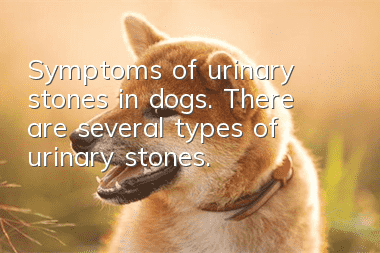Symptoms of urinary stones in dogs. There are several types of urinary stones.

Symptoms of urinary stones in dogs
Bladder stones
1. Difficulty urinating, hematuria, and frequent urination, but only a small amount of urine is excreted each time.2. During bladder palpation, multiple stones can be felt rubbing against each other or hard bladder stones can be palpated. When cystitis occurs, it can be reflected by urinalysis. Abnormal findings include an increase in white blood cells, red blood cells, and protein, an abnormally elevated pH, and a large number of bacteria in the urine.
Urethra stones
1. It is a complication of bladder stones, with frequent urination but only a small amount of hematuria or no urine at all.2. The dog appears restless and in pain, has difficulty walking, and has severe pain when palpating the bladder in the posterior abdomen. Long-term urinary retention can cause uremia.
3. Dogs are depressed, vomiting, exhaled air smells of ammonia, dehydrated, and have increased blood urea nitrogen and creatinine levels. The dog's bladder is extremely distended and has severe loss of elasticity, which may lead to bladder rupture.
4. X-ray photography is of great diagnostic significance for urinary system diseases caused by stones.
Causes of urinary stones in dogs
1. The dog’s drinking water decreases and the concentration of salts increases, which promotes the precipitation of crystal substances.2. Vitamin A deficiency and estrogen excess promote the shedding of epithelial cells to form the core of stones.
3. Urinary tract infection.
4. Metabolic abnormalities can cause cystine stones.
5. Changes in urine pH. Phosphates and carbonates tend to precipitate in alkaline urine, while urate, oxalate, and cystine tend to precipitate in neutral or acidic urine.
6. Dogs that eat pure meat have a higher incidence rate.
Treatment methods for dog urinary stones
1. If a dog has bladder stones that have shown clinical symptoms, surgical incision of the bladder to remove the stones should be considered.2. For urethral stones, retrograde urethral flushing can be performed. Insert the catheter into the dog's urethra, and then inject an equal amount of a mixture of normal saline and liquid paraffin into the dog's urethra while compressing the urethra at the pelvic edge. When the urethral pressure increases, quickly release and withdraw the urinary catheter, which can be repeated several times.
3. If retrograde flushing is unsuccessful, perform urethrotomy as soon as possible to remove the dog’s urethral stones.
Random articles
- What do dogs eat to protect their stomach? It is important to protect their stomach and treat gastrointestinal diseases in dogs.
- How to tell if your dog is fat? Is your dog overweight?
- Will your dog catch a cold if you blow the air conditioner? What should you do if your dog catches a cold if you blow the air conditioner?
- What should you pay attention to when your dog drinks water? Don’t be careless when it comes to your dog’s drinking water.
- The dog's mouth bites and shakes. Why does the dog's mouth occasionally shake and bite?
- How to cut a dog's hair? Do you know how to cut a dog's hair correctly?
- Can dogs eat raw eggs? Why can’t dogs eat egg whites?
- Common Dog Problems in Summer How to Deal with Different Dog Problems
- How to keep dogs away from skin diseases. If you do this, will you see if your dog will still be infected with skin diseases?
- What causes anorexia in dogs? Dogs will become anorexic due to lack of exercise. Hounds run at least 5KM every day.



